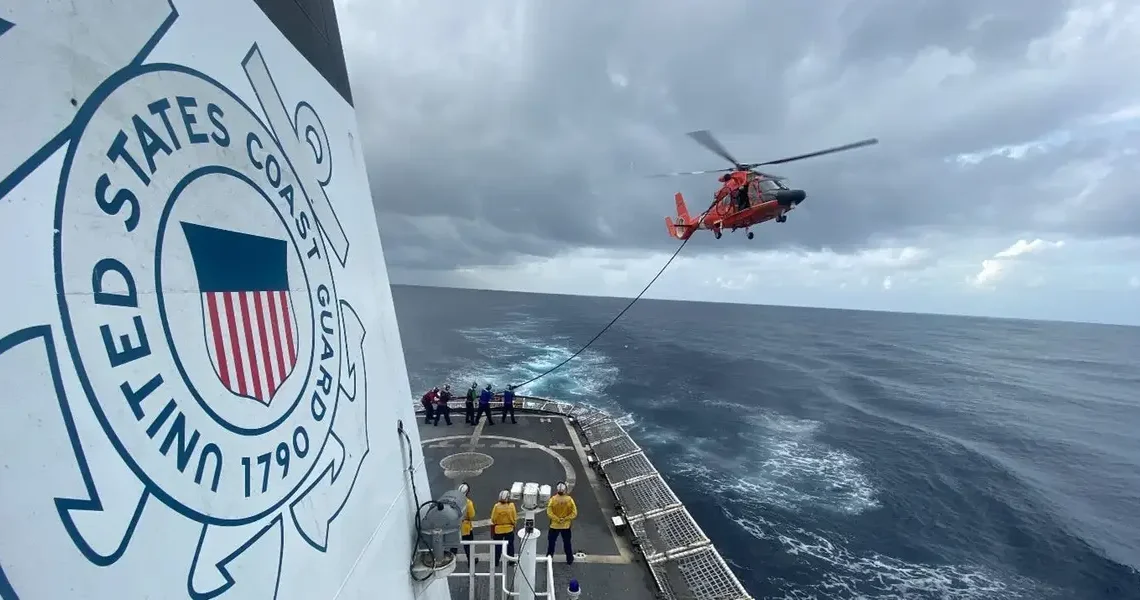USCG HITRON JACKSONVILLE, Florida — In the eastern Pacific and Caribbean waters, Coast Guard helicopter teams are chasing down suspected drug boats, putting vessels out of action, and setting the stage for boarding.
The elite pilots and precision marksmen of the Helicopter Interdiction Squadron, or HITRON, have to be prepared for drug interdiction operations to go sideways. It could be night, the drug boat could be zigging and zagging everywhere trying to get away, and suspects could be jumping overboard.
No matter what the pilots have to be ready to keep up the chase, and the shooters on board have to be able to make the shot when it matters.
Business Insider had the opportunity recently to see them in action, training for these missions, aimed at curbing the flow of dangerous narcotics into the US.
“It’s like running with ankle weights on,” Lt. Com. Jamel Choker, a pilot and mission commander at HITRON, told Business Insider, speaking on the intensity of the training that goes into preparing for actual missions. “You want to train as hard as possible so that when you get out in the real world, it’s kind of easier.”
The Coast Guard formally stood up HITRON in 2003 at Cecil Field in Jacksonville, Florida. Over the recent decades, it’s been involved in over 1,000 interdictions resulting in billions of dollars worth of drugs seized from smugglers.
HITRON’s helicopter pilots arrive as trained and experienced aircraft commanders. No matter what they flew before, they learn the ins and outs of Coast Guard helicopters like the MH-65 Dolphin — older airframes that go through a dedicated maintenance pipeline, leaving Cecil Field and returning looking brand new.
Choker described the job as unique because it’s both aviation and law enforcement, and the missions can quickly change from hunting drug boats to search and rescue in the water to flagging suspected drug cargo if it goes overboard.
Split-second decisions
Just last week, Choker and his crew received an award for a pursuit in which a drug boat was making “tight turns and zig-zags and everything,” he said, before its passengers suddenly started jumping overboard.
“All four of them jumped in the water,” Choker said. “They left the throttle engaged, and they left the wheel cut to the right.”
Coast Guard personnel then switched to search and rescue mode, deploying life rings. As they were trying to help, they saw the renegade vessel circle around beneath the helicopter out of view. The boat was heading right for one of the smugglers in the water. It would’ve been a serious hit.
“We made a split-second decision that we were going to use the precision rifle to disable the boat,” Choker shared. It took the gunner nine rounds in under five seconds to cut the engines. “It came within five feet of running him over,” he said.
At Cecil, Coast Guard pilots and marksmen are constantly flying and training when they’re not on deployments, which regularly last months at a time. They practice against a team pretending to be drug traffickers, who will change up tactics based on what’s been observed from recent real-world runs.
The actual piloting of the Dolphin is something that’s “predictable and intuitive to you when you’ve been training for thousands of hours,” Choker told Business Insider. “It does take a lot of training in order to know that I need the helicopter to do an extreme angle of bank, and I need to only move my hand three-fourths of an inch in order to do that.”
Precision marksmen are likewise constantly training to get the perfect shot while maintaining clear communication with the pilots. The training pipeline requires knowledge of what weapons to use for specific purposes.
The mounted machine gun on the Dolphin is for firing warning shots when a suspected drug vessel doesn’t stop after initial verbal warnings. Other rifles, like the M107 semi-automatic .50 caliber sniper rifle and M110 Semi Automatic Sniper System chambered for 7.62×51mm NATO-standard rounds, are useful for knocking out vessel engines depending on the size.
The M107 is effective at longer range against harder targets, like enemy vehicles, while the M110 is suited to engaging personnel and lightly protected material targets.
Petty Officer Second Class Phillip McCarty, an avionics electrical technician and precision marksman at HITRON, told Business Insider that training, both on land and in air, is designed to prepare marksmen for the challenges of shooting effectively during interdictions, when a helicopter flies alongside a moving boat and pilots help the marksmen line up their shot.
The pilots have to match speed and attempt to maneuver to provide the best shot, but the shooters have to be prepared to overcome vibrations, jarring movements, and other potential impacts.
While they want to make every shot count, getting a clean hit to disable the vessel is easier said than done, especially when suspected drug boats try to make a run for it.
He said he’s had cases where it only took four rounds to stop a smuggling boat, but there have been others where the drug runners were “very erratic and driving all over the place and at nighttime.” That took 32 rounds to kill the engine.
Depending on the circumstances, environment, and drug runner tactics, the marksmen find themselves having to embrace HITRON’s adapt and overcome strategy. “You’ve got to change your methodology on the fly out there,” McCarty said.
Read the original article on Business Insider
The post How Coast Guard pilots and sharpshooters leave drug boats dead in the water, from helicopter chases to shooting out the engines appeared first on Business Insider.




